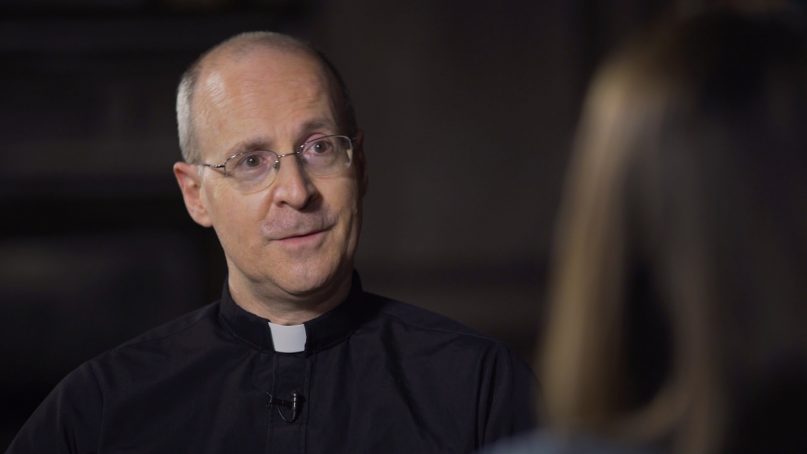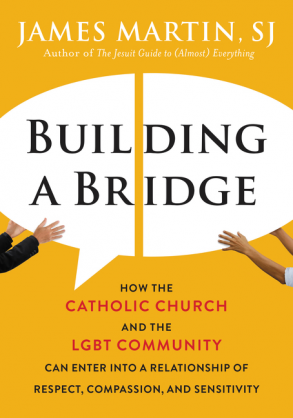(RNS) In 1992, the Vatican under Pope John Paul II published the Catechism of the Catholic Church, which stated, among many other things, that “homosexual tendencies” are “objectively disordered.” One of the principal theologians who shaped the document was Cardinal Joseph Ratzinger, who would succeed John Paul II as Pope Benedict XVI. He too would take a hard-line stance against homosexuality.
Two decades later, Pope Francis has signaled what many believe to be a softening on the matter.
In 2013, when asked about gay priests, he famously replied, “Who am I to judge?” He has continued to call for the Catholic Church to treat LGBT people with dignity and respect, and to fight discrimination against sexual minorities.
But the church may be on the cusp of another baby step in this ongoing discussion with the publication of a new book by a popular Jesuit priest, James Martin: “Building a Bridge: How the Catholic Church and the LGBT Community Can Enter Into a Relationship of Respect, Compassion, and Sensitivity.”
Martin argues the church must move from a position of tolerance to inclusion when it comes to LGBT people. He criticizes the language of disorder from the catechism, calls on Catholics to stop firing LGBT people from church positions and frequently uses terms like “gay” and “lesbian” that many Catholic officials avoid.
RELATED: Top Vatican and US church officials back new gay-friendly book
The book carries with it a sense of authority. It was approved by Martin’s Jesuit superiors and is endorsed by two Catholic cardinals and a bishop. And Martin was recently appointed by Francis as consultant to the Vatican’s Secretariat for Communication, which manages Vatican TV and radio as well as the pope’s social media presence.
I sat down with Martin to discuss his message, and he told me he isn’t the only person connected to the Vatican who wishes to see the church move toward LGBT inclusion. Here we discuss what that looks like, how likely it is to happen and why he is putting his reputation on the line to fight for it.
You’re arguing for inclusion of LGBT in Catholic churches. How is it possible to include someone that your church believes is actively living in sin?
Simply being LGBT is not sinful, according to Catholic teaching. That’s a common misconception. Even the catechism talks about welcoming them with “respect, compassion and sensitivity,” which is the genesis of the book’s subtitle. More basically, LGBT Catholics are baptized, and so they’re as much a part of the church as the pope. Sometimes when LGBT people tell me they feel like they’re being pushed out of the church, I’ll say, “Don’t let anyone push you out. It’s your church too.”
Let’s assume you’re successful and churches open their arms to the LGBT community. Is it even possible for LGBT people to feel welcome in the Catholic Church?
Yes, and many parishes show what this means in practice. Of course, some parishes are more forward-thinking and have LGBT support groups, like the successful “Out at St. Paul” group at the Church of St. Paul the Apostle in New York. But there are quieter ways of welcoming LGBT people — mentioning them in homilies; encouraging them to participate as lectors, ministers of hospitality and in other parish ministries, and getting to know them personally. And, above all, listening to them.
A lot of Catholic leaders avoid using labels like “gay” and “lesbian,” opting instead for terms like “same-sex attracted.” Why did you decide to use the more common labels?
Because those are the terms that LGBT people use. People have a right to name themselves. It’s similar to the reason we no longer use terms like “Negro.” Why not? Because the African-American community opted for terms like “African-American” and “black” over time. Catholics are supposed to treat LGBT people with “respect,” and it’s disrespectful in the extreme to continue to use names that they not only don’t use, but reject.
The Catechism of the Catholic Church teaches that “homosexual acts are intrinsically disordered.” Do you affirm and agree with this teaching and language?
I’m no theologian, but I would say that some of the language used in the catechism on that topic needs to be updated, given what we know now about homosexuality. Earlier, for example, the catechism says that the homosexual orientation is itself “objectively disordered.” But, as I say in the book, saying that one of the deepest parts of a person — the part that gives and receives love — is disordered is needlessly hurtful. A few weeks ago, I met an Italian theologian who suggested the phrase “differently ordered” might convey that idea more pastorally.
Can you understand the pain that LGBT Catholics have felt?
Absolutely. Over the past 20 years, I’ve done what you might call an “informal ministry” with LGBT Catholics. They’ve come to me for spiritual counseling, confession and conversation. And they’ve told me the most appalling stories of being ignored, excluded and insulted — by priests and lay workers in their parishes. There is simply no group as marginalized in the Catholic Church as LGBT people. Sometimes they’re treated like lepers. So yes, I understand their pain.
Recognizing that this is just conjecture, how do you predict the Catholic Church’s teaching on homosexuality will be different in 100 years?
I hope that the church would more fully embrace Jesus’ call to reach out to those on the margins, those who feel excluded. In the past, when it came to the LGBT community, we led with condemnations. Which is not what Jesus does. For Jesus it is, more often than not, a welcome first. Think of the story of Zacchaeus, the chief tax collector in Jericho, who would have been considered the chief sinner in the city. As he’s passing through Jericho, Jesus sees him and says, “Tonight, I must dine at your house!” It’s a public sign of welcome. That came first for Jesus, and that’s what should come first for the church.
What kind of pushback do you expect to receive?
Most likely, some church leaders will think I’ve gone too far, and some LGBT people will think I haven’t gone far enough. A few church leaders might find the call to stop firing LGBT people in same-sex marriages a challenge, and some LGBT Catholics might find my call to treat the hierarchy with respect a challenge. On the other hand, the book has been endorsed by two cardinals, one of them an official in the Vatican. So I think there’s an opening here. And the LGBT people who have read it have thanked me for writing it. So something is changing in the church. Something new is happening. I think it’s the right time for a book like this.
(RNS Senior Columnist Jonathan Merritt writes the “On Faith and Culture” column)







